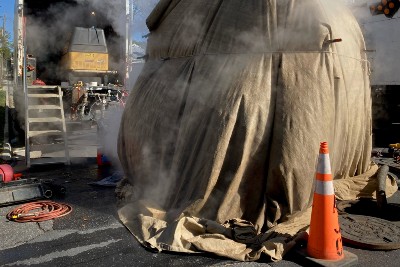
Two concrete pipes from the 1960s that had been leaking groundwater near Memorial Hall were repaired earlier this year with little impact on area roads and traffic flow.
This week, a pipe in the Bruce Street area was able to be fixed without tearing up the recently paved roadway.
With both projects, Harrisonburg Public Utilities took another step toward its Sanitary Sewer Management Plan goal for reducing infiltration and inflow in the public sanitary sewer collection system. The way the department did it is an innovative effort that saves money and reduces impacts on the surrounding community.
A mission of the Public Utilities SSMP is to meet local, state and federal benchmarks and requirements for conveyance of sanitary sewer. A key part of this is groundwater infiltration, which can seep into sanitary sewer pipes through holes or cracks in aging infrastructure; and stormwater inflow, which often is caused by heavy storm events or snow melt that contribute to excessive sewer flows and can cause backups and pooling of water.
In the instance of the Memorial Hall-area project, aging pipes along South High Street were leaking significant amounts of groundwater into the collection system, which reduces the capacity of the system and can lead to hydraulic-derived sanitary sewer overflows. Additionally, treating the groundwater at the Harrisonburg-Rockingham Regional Sewer Authority would create an unwelcome and unnecessary cost to Harrisonburg residents.
To rehabilitate the pipe while minimizing traffic impacts in the area, Public Utilities Engineering chose to line the 15-inch concrete pipe. This effort consists of inserting a thermally heated PVC pipe into the host pipe, and then pressurizing the PVC liner pipe so it expands. The new PVC pipe expands tight against the existing pipe, thus eliminating the leaks while providing nearly the same capacity as the older pipe, all while not requiring service disruptions.
This week, Public Utilities took the same approach to a smaller pipe underneath Bruce Street. The roadway was paved last year, and tearing it up to remove and replace the leaking pipe would have been costly and caused traffic disruption for the neighborhood.
This lining process is one Public Utilities uses across Harrisonburg to rehabilitate aging or damaged pipes while resulting in the fewest impacts and costs to residents and businesses.
“Reducing infiltration and inflow in the public sanitary sewer collection system is a key goal of ours,” Harrisonburg Public Utilities Engineer Senior James Fultz said. “The High Street pipe issue was one of the most severe leaks we have seen in some time, and we are glad to say it has been corrected and we have been able to address a significant I&I issue in our community.”
You can learn more about the SSMP at www.harrisonburgva.gov/water-engineering.










